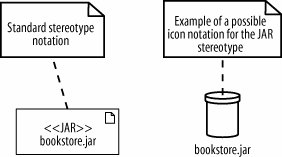Section B.2. Stereotypes
B.2. StereotypesStereotypes signify that an element has a special use or intent. Stereotypes are most often shown by specifying the name of the stereotype between two guillemots, as in <<stereotype_name>>; you can substitute angle brackets if you don't have guillemots available on your system, as shown in Figure B-1. Figure B-1. An artifact with a JAR stereotype applied to it; this is an example of a stereotype you might see in a J2EE profileIf a stereotype has an icon associated with it, you may also display the element with its icon. UML tools generally allow you to switch between these display options. Figure B-2 shows the standard JAR stereotype display notation as well as an example JAR icon. Figure B-2. Using the <<JAR>> Stereotype and a JAR icon There is no limit to the number of stereotypes that can be applied to a particular element, as shown in Figure B-3. Figure B-3. The bookstore.jar has both the JAR and file stereotype applied to it |
Learning UML 2.0
ISBN: 0596009828
EAN: 2147483647
EAN: 2147483647
Year: 2007
Pages: 175
Pages: 175
Authors: Russ Miles, Kim Hamilton
- ERP Systems Impact on Organizations
- The Second Wave ERP Market: An Australian Viewpoint
- Context Management of ERP Processes in Virtual Communities
- Distributed Data Warehouse for Geo-spatial Services
- Relevance and Micro-Relevance for the Professional as Determinants of IT-Diffusion and IT-Use in Healthcare